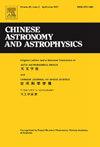Research on Image Reconstruction Method of Lunar Hydrogen Distribution Based on Simulation
Q4 Physics and Astronomy
引用次数: 0
Abstract
Obtaining an accurate distribution map of lunar water hydrogen has significant scientific value for research on detecting water ice and for future deep space exploration. In order to effectively explore the water ice resources on the Moon, it is necessary to accurately detect their distribution. In practical applications, a point spread function with shifting characteristics is constructed based on the detection principle of neutron detectors and the process of satellite image degradation, due to the lack of effective and reliable image sources. The point spread function is based on the kappa function. The image is blurred and made noisy to create a simulated detection image. Then, the maximum entropy algorithm and Richardson-Lucy algorithm are utilized to reconstruct the simulated detection image. The evaluation criteria for comparative study include visual effect, chi-square test, and authenticity test. The experimental results show that direct reconstruction cannot achieve optimal reconstruction results under both low and high levels of noise. After applying denoising preprocessing, ensuring the safety of the chi-square test, the overall effect of the reconstruction results is found to be better than before preprocessing. Additionally, there is a significant reduction in the number of points with large deviation in the authenticity test of the reconstructed image. This indicates that the reconstruction results are now more accurate and reliable. It will provide more accurate data support for the exploration of water ice resources and deep space exploration.
基于仿真的月球氢分布图像重建方法研究
准确获取月球水氢分布图,对探测水冰的研究和未来深空探测具有重要的科学价值。为了有效地探索月球上的水冰资源,有必要对其分布进行准确探测。在实际应用中,由于缺乏有效可靠的图像源,基于中子探测器的探测原理和卫星图像的退化过程,构造了具有位移特征的点扩展函数。点扩散函数是基于kappa函数的。图像被模糊和噪声,以创建一个模拟的检测图像。然后,利用最大熵算法和Richardson-Lucy算法重建模拟检测图像。比较研究的评价标准包括视觉效果、卡方检验和真实性检验。实验结果表明,在低噪声和高噪声条件下,直接重构都不能获得最佳的重构效果。在保证卡方检验安全性的前提下,进行去噪预处理后,发现重建结果的整体效果优于预处理前。此外,在重建图像的真实性测试中,具有较大偏差的点的数量也显著减少。这表明重建结果更加准确可靠。它将为水冰资源勘探和深空探测提供更准确的数据支持。
本文章由计算机程序翻译,如有差异,请以英文原文为准。
求助全文
约1分钟内获得全文
求助全文
来源期刊

Chinese Astronomy and Astrophysics
Physics and Astronomy-Astronomy and Astrophysics
CiteScore
0.70
自引率
0.00%
发文量
20
期刊介绍:
The vigorous growth of astronomical and astrophysical science in China led to an increase in papers on astrophysics which Acta Astronomica Sinica could no longer absorb. Translations of papers from two new journals the Chinese Journal of Space Science and Acta Astrophysica Sinica are added to the translation of Acta Astronomica Sinica to form the new journal Chinese Astronomy and Astrophysics. Chinese Astronomy and Astrophysics brings English translations of notable articles to astronomers and astrophysicists outside China.
 求助内容:
求助内容: 应助结果提醒方式:
应助结果提醒方式:


